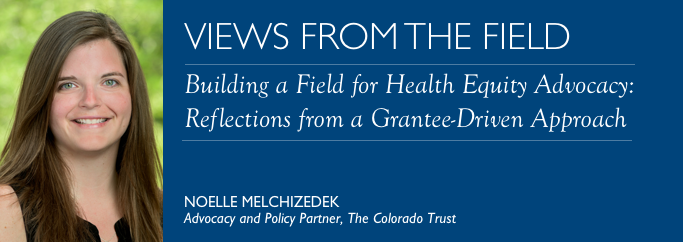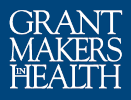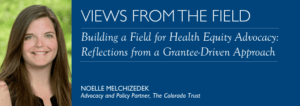
The Colorado Trust believes that all Coloradans should have fair and equal opportunities to lead healthy, productive lives regardless of race, ethnicity, income, or where we live. Unfair social, systemic, and institutional dynamics perpetuate inequalities due to race, gender, income, and education among other factors, which leave some populations out of the opportunity for a healthy life. Effective, efficient, and inclusive advocacy and public engagement efforts can lead to positive changes in those dynamics, in turn supporting those who comprise the communities most affected by health inequities.
The Trust chose to invest in advocacy through a field-building approach called the Health Equity Advocacy Strategy (HEAS). HEAS, at its core, is a partnership, comprised of a group of 18 direct service, community organizing, and policy advocacy grantees called “the cohort”; Social Policy Research Associates (SPR), an evaluation firm; and The Colorado Trust. This $19.2 million multiyear strategy is intended to build a strong and diverse field of health equity advocates. Building a strong field of advocates—rather than merely strong individual advocacy organizations operating in isolation—leads to greater sustainability and to advocates’ abilities to successfully respond to a changing political climate.
Since 2013 when the first phase of HEAS began, numerous changes have occurred to strengthen, improve, and at times confuse, this effort. A few initial reflections can provide insight to others interested in this funding approach to advocacy.
Power Dynamics and the Grantee-Driven Model
At the strategy’s core is the recognition that the grantees in the field – direct service, policy advocacy, and community organizing groups – are the experts. At its start, some grantees were already identifying with and working on the concept of health equity; others had not yet explored the social determinants of health. When it came to building a field, this cohort needed to lead and own the process. In recognition of their expertise, the Trust decided that virtually all aspects of decisionmaking would be driven by the grantees.
As this grantee-driven work has unfolded, it is clear the cohort is leaderfull, not leaderless. Each member is a leader and participates in different ways depending on their capacity, interest, and the degree to which the work adds value to their organizations’ goals and missions. There is natural tension between the goals of building the field, talking about and prioritizing collective action, and the reality of individual organizational goals. This tension that may never be resolved, but it is leveraged as work aligns in the larger goal of field-building.
The Trust realized that for grantees to own decisionmaking, an honest and transparent conversation about power dynamics was needed.
To disrupt these power dynamics requires a combination of answerability and enforceability, concepts articulated by Justin Laing of the Heinz Endowment, in the Stanford Social Innovation Review blog post: Grantee Inclusion: A Step Towards Mutual Accountability? “Answerability involves sharing information and explaining decisions. Enforceability involves the ability to enact consequences for the violation of rules.” He writes, “These two dimensions bring up a sea of complexities: what rules? What information?” The Trust would add, whose rules? Whose information? As this strategy unfolds the entire partnership intentionally speaks to the implications of power and what it means for a grantee-driven strategy.
Shifting to a Grantee-Driven Model
In the grantee-driven model, Trust staff have given considerable thought to how to share and build power within and with the cohort. This grantee-driven aspect has been operationalized in the following ways:
- The Trust created the what (field building); the cohort drives the how. All capacity building activities are designed and implemented by the cohort, with the Trust providing facilitation and logistics support. The cohort created a consensus decisionmaking process and they included the Trust as a thought partner, but not a decisionmaker.
- The cohort alone decides on which policy advocacy actions they focus on. The Trust has no expectations regarding their focus, what activities will be undertaken, or what resources are needed to accomplish advocacy activities. Direct service and community organizing grantees provide the context of what affected populations say about specific policy issues while the policy advocacy grantees lend their significant systems expertise.
- The Trust’s mission is centered on health equity, but the cohort defines what that means for them. In doing so, the cohort decided, without The Trust’s influence, to address health equity through a racial equity lens. Convenings begin with specific activities designed to deepen participants’ equity journeys toward becoming diverse and inclusive organizations. Some grantees, taking a more antiracism approach, have created a toolkit, Impacting Racial Equity through Organizational Transformation from the Inside Out to further this work.
- The Trust defined the organization typologies, direct service, community organizing, and policy advocacy, noting that direct service providers are rarely funded to be policy advocates. The cohort created the structure and defined the ways in which they work together. The cohort meets quarterly in person and has created advocacy issue teams and field building function teams. Several meetings a month occur over videoconferencing and phone calls, and even in-person retreats. Examples of advocacy issues that may be a “team” in 2017 include immigrant access to health care or housing affordability. Function teams address further building the field, such as developing a field-wide language for health equity that can be shared across political ideologies, organization types, systems, and communities, or engaging affected populations directly in policy advocacy.
- The Trust chose the number of initial grantees in the cohort, but the cohort will bring in their specific network partners into the work through small ‘network grants’ that they themselves individually allocate. Organizations will be identified through a social network analysis process, via criteria cocreated by the cohort. These grants will begin in 2017.
- While the funding parameters were set by the Trust in the first years of the strategy, the cohort wrote and presented to the board of trustees the next phase of the work. By doing this, the grantees defined how they wanted to build the field and what resources were needed. Grantees felt capacity-building and the network partner grants were so critical to field-building, they cut their initial general operating request to designate funds to these areas. This was the first time in the The Colorado Trust’s history that grantees determined the entire content and direction of a funding strategy – and had a deep and authentic conversation with the board of trustees in the process.
Building a grantee-driven funding model, addressing power dynamics within a foundation, and at the same time building a strong field of advocates takes considerable time. This strategy is expected to continue at least through 2019. Several years into the work, more resources and opportunities are strengthening the cohort and expand the reach of effective advocates in Colorado.
The evaluation being conducted by SPR is documenting the success of the field-building strategy by tracking:
- The creation of a shared understanding and vision around health equity.
- The increase in the diversity of organizations in the health equity field, with specific attention to assuring that vulnerable populations are represented.
- The increase in the capacity of organizations working on health equity issues, especially with respect to how these capacities complement one another within the larger field.
- The intentional coordination and collaboration amongst organizations working to advance health equity solutions.
Ultimately, the cohort is working towards a vision they created for their work together: diverse Colorado leaders, united by common values and empowered communities, who dismantle structural and racial inequities and build equitable systems so that all Coloradans can achieve their highest possible level of health.

